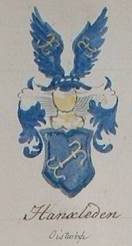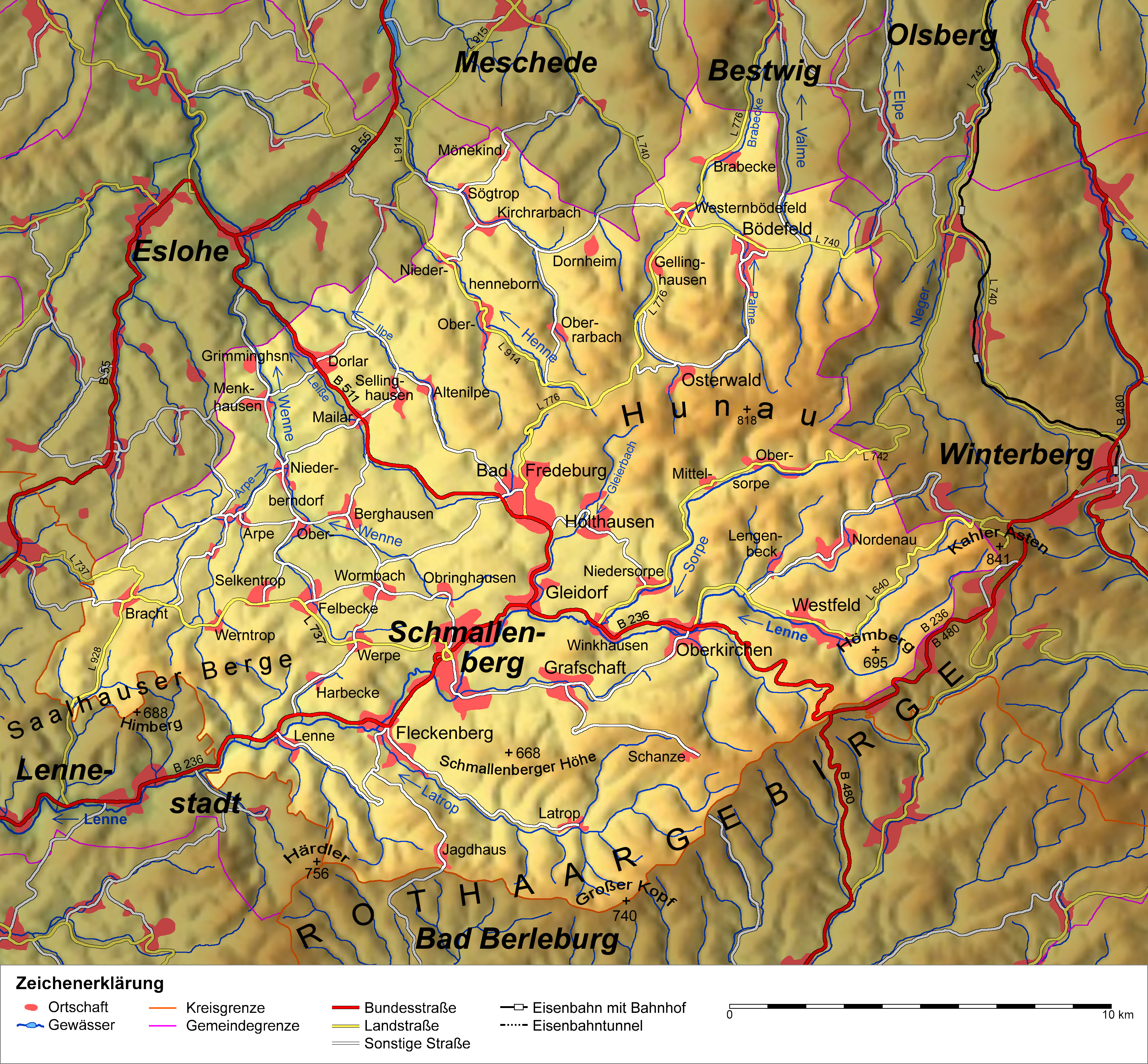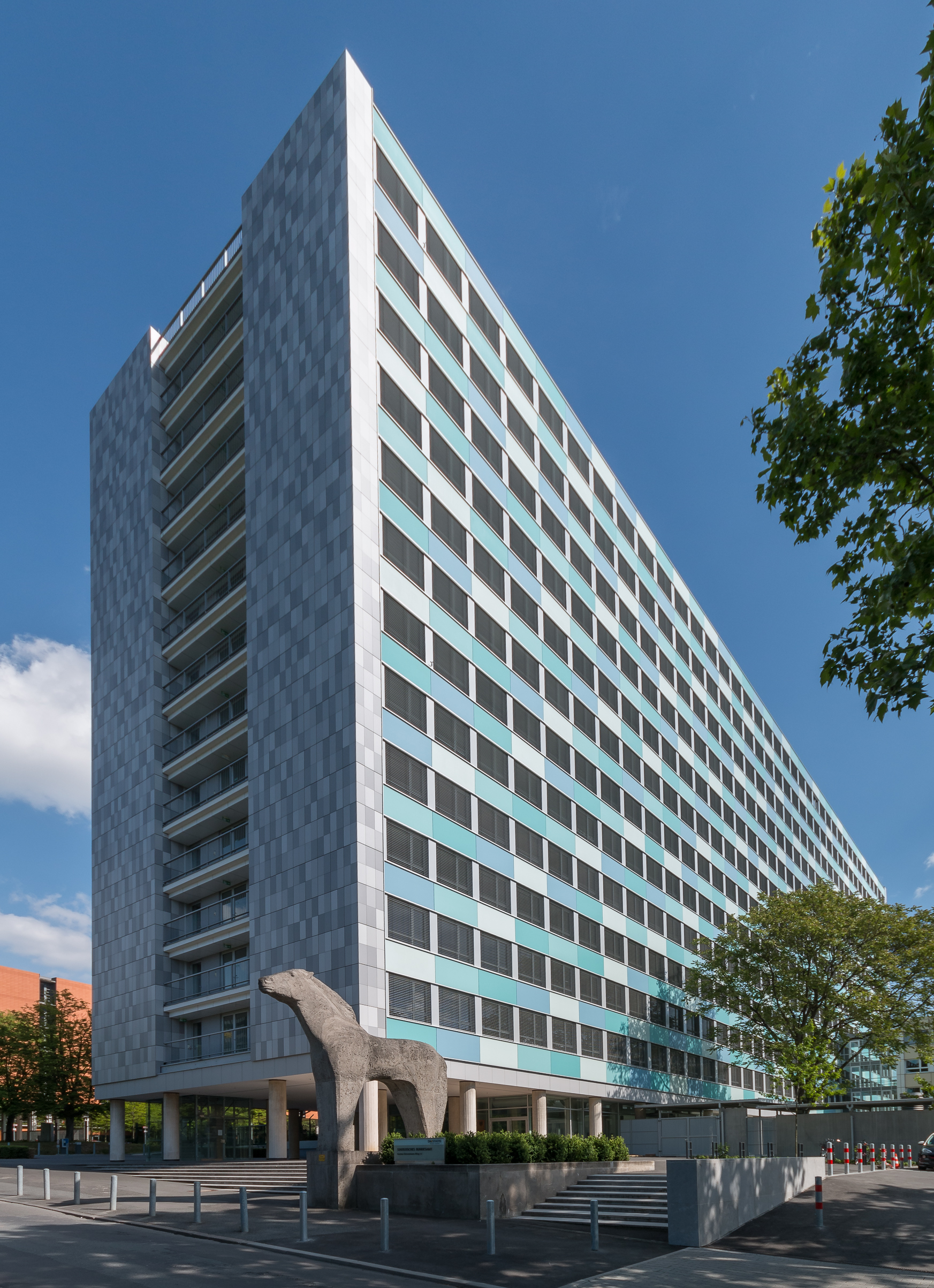|
Bödefeld
Bödefeld is a locality in the municipality Schmallenberg in the High Sauerland District in North Rhine-Westphalia, Germany. The village has 1102 inhabitants and lies northeastern of the municipality of Schmallenberg at a height of around 488 m. The river Palme flows through the village. Bödefeld borders on the villages of Gellinghausen, Westernbödefeld, Brabecke, Osterwald, Obervalme (Bestwig), Lanfert, Hiege and Walbecke. The first written document mentioning ''Buodevelden'' dates from 1072 in a charter from Grafschaft Abbey of bishop Anno of Cologne. Hunold von Hanxleden was bailiff of Fredeburg and Lord (Herr) of Bödefeld. In 1410 he was granted permission by the Electorate of Cologne to build the castle of Bödefeld. Construction lasted from 1425 to 1428. The village used to belong to the municipality of Freiheit Bödefeld in Amt Fredeburg until the end of 1974.Statistisches Bundesamt (Hrsg.): Historisches Gemeindeverzeichnis für die Bundesrepublik Deutschland. Name ... [...More Info...] [...Related Items...] OR: [Wikipedia] [Google] [Baidu] |
Hanxleden
The Hanxleden is a Westphalian noble family whose seat is the village of , today part of Schmallenberg in the district of Hochsauerland in Germany. In the 14th and 15th centuries the family provided several bailiffs (''Amtmänner'') of Fredeburg. History Family tree ''Siegfried von Hanxleden'' (b about 1180, d after 1279) lived as knight (''Ritter'') in Hanxleden and took part in the Fifth Crusade from 1217 to 1221. After his return he founded, together with his neighbour, the Lord (''Herrn'') of Sögtrop, a church and a rectorate on the common estate boundary, from which the village of Kirchrarbach developed. ''Albert von Hanxleden'' (b about 1200), was mentioned about 1216 and may have been his son. ''Johann I von Hanxleden'' (b about 1260) was mentioned in 1326 and may have been a grandson of Albert von Hanxledens. ''Goddert I von Hanxleden'' (b about 1290) was 1327-1358 mentioned. He was Lord (''Burgmann'') of Grevenstein, Fredeburg and Schwarzenberg as well as ba ... [...More Info...] [...Related Items...] OR: [Wikipedia] [Google] [Baidu] |
Schmallenberg
Schmallenberg ( Westphalian: ''Smalmereg'') is a town and a climatic health resort in the High Sauerland District, Germany. By area, it is the third biggest of all cities and towns of the state of North Rhine-Westphalia and the second biggest of the region of Westphalia. With small Schmallenberg central town and the rural Bad Fredeburg Kneipp health resort the town has two urban settlements. Additionally, 82 villages and hamlets belong to the town's territory. Also being called “the Schmallenberg Sauerland”, the Town of Schmallenberg is famous for its total of fiveStadt Schmallenberg: Kurort health resorts and nineSchmallenberger Sauerland: Golddörfer Schmallenberg und Esloh villages which have been awarded gold for their beauty in the nationwide “” contest. Geography Schmallenberg is located in the southeast of the Sauerland mountainous landscape. The Rothaar Mountains make up a part of the town's territory. Through the central town flows the river Lenne. It is sit ... [...More Info...] [...Related Items...] OR: [Wikipedia] [Google] [Baidu] |
Gellinghausen
Gellinghausen is a locality in the municipality Schmallenberg in the district Hochsauerlandkreis in North Rhine-Westphalia, Germany. The village has 97 inhabitants and lies in the north of the municipality of Schmallenberg at a height of around 480 m. Gellinghausen borders on the villages of Westernbödefeld, Bödefeld, Osterwald, Rimberg, Oberrarbach and Dornheim. The Gellinghausen brook flows through the village. The Landstraße 776 on the outskirts runs parallel to Dorfstrasse. Gellinghausen was first mentioned in 1280 in a document. The village used to belong to the municipality of Bödefeld Land in Amt Fredeburg until the end of 1974. Statistisches Bundesamt (Hrsg.): Historisches Gemeindeverzeichnis für die Bundesrepublik Deutschland. Namens-, Grenz- und Schlüsselnummernänderungen bei Gemeinden, Kreisen und Regierungsbezirken vom 27.5.1970 bis 31.12.1982. W. Kohlhammer W. Kohlhammer Verlag GmbH, or Kohlhammer Verlag, is a German publishing house headquartered in S ... [...More Info...] [...Related Items...] OR: [Wikipedia] [Google] [Baidu] |
Westernbödefeld
Westernbödefeld is a locality in the municipality Schmallenberg in the district Hochsauerlandkreis in North Rhine-Westphalia North Rhine-Westphalia (german: Nordrhein-Westfalen, ; li, Noordrien-Wesfale ; nds, Noordrhien-Westfalen; ksh, Noodrhing-Wäßßfaale), commonly shortened to NRW (), is a States of Germany, state (''Land'') in Western Germany. With more tha ..., Germany. The village has 316 inhabitants and lies in the north of the municipality of Schmallenberg at a height of around 443 m. Westernbödefeld borders on the villages of Brabecke, Bödefeld, Gellinghausen, Dornheim ... [...More Info...] [...Related Items...] OR: [Wikipedia] [Google] [Baidu] |
Arnsberg (region)
Arnsberg () is one of the five Regierungsbezirke of North Rhine-Westphalia, Germany, located in the west-central part of the country. It covers the Sauerland hills as well as the east part of the Ruhr area. The region was founded in 1815 as a subdivision of the Prussian Province of Westphalia. ''Kreise''(counties) # Ennepe-Ruhr # Hochsauerland # Märkischer Kreis # Olpe # Siegen-Wittgenstein # Soest # Unna Unna is a city of around 59,000 people in North Rhine-Westphalia, Germany, the seat of the Unna district. The newly refurbished Unna station has trains to all major cities in North Rhine Westphalia including Dortmund, Cologne, Münster, Hamm, ... ''Kreisfreie Städte''(independent cities) # Bochum # Dortmund # Hagen # Hamm # Herne Economy The Gross domestic product (GDP) of the region was 124.8 billion € in 2018, accounting for 3.7% of German economic output. GDP per capita adjusted for purchasing power was 32,000 € or 106% of the EU27 average in the s ... [...More Info...] [...Related Items...] OR: [Wikipedia] [Google] [Baidu] |
Hochsauerlandkreis
Hochsauerlandkreis (meaning “High Sauerland District” in German) is a Kreis (district) in the east of North Rhine-Westphalia, Germany. Neighboring districts are Soest, Paderborn, Höxter, Waldeck-Frankenberg, Siegen-Wittgenstein, Olpe, Märkischer Kreis. The district is named “High Sauerland” because two of the highest mountains of the Sauerland mountainous landscape, Langenberg and Kahler Asten are in its territory. With 2,766 ft / 843 m (Langenberg) and 2,762 ft / 842 m (Kahler Asten) these are also the highest mountains of North Rhine-Westphalia. History The district was established in 1975 in the reorganization of the districts in North Rhine-Westphalia by merging the previous districts Arnsberg, Brilon and Meschede. Geography Geographically the district covers a big part of the Sauerland mountains, including the highest and third highest elevation – the Langenberg near Olsberg with 2,766 ft / 843 m, and the better known Kahler Asten with 2 ... [...More Info...] [...Related Items...] OR: [Wikipedia] [Google] [Baidu] |
North Rhine-Westphalia
North Rhine-Westphalia (german: Nordrhein-Westfalen, ; li, Noordrien-Wesfale ; nds, Noordrhien-Westfalen; ksh, Noodrhing-Wäßßfaale), commonly shortened to NRW (), is a States of Germany, state (''Land'') in Western Germany. With more than 18 million inhabitants, it is the List of German states by population, most populous state of Germany. Apart from the city-states, it is also the List of German states by population density, most densely populated state in Germany. Covering an area of , it is the List of German states by area, fourth-largest German state by size. North Rhine-Westphalia features 30 of the 81 German municipalities with over 100,000 inhabitants, including Cologne (over 1 million), the state capital Düsseldorf, Dortmund and Essen (all about 600,000 inhabitants) and other cities predominantly located in the Rhine-Ruhr metropolitan area, the largest urban area in Germany and the fourth-largest on the European continent. The location of the Rhine-Ruhr at the h ... [...More Info...] [...Related Items...] OR: [Wikipedia] [Google] [Baidu] |
Germany
Germany,, officially the Federal Republic of Germany, is a country in Central Europe. It is the second most populous country in Europe after Russia, and the most populous member state of the European Union. Germany is situated between the Baltic and North seas to the north, and the Alps to the south; it covers an area of , with a population of almost 84 million within its 16 constituent states. Germany borders Denmark to the north, Poland and the Czech Republic to the east, Austria and Switzerland to the south, and France, Luxembourg, Belgium, and the Netherlands to the west. The nation's capital and most populous city is Berlin and its financial centre is Frankfurt; the largest urban area is the Ruhr. Various Germanic tribes have inhabited the northern parts of modern Germany since classical antiquity. A region named Germania was documented before AD 100. In 962, the Kingdom of Germany formed the bulk of the Holy Roman Empire. During the 16th ce ... [...More Info...] [...Related Items...] OR: [Wikipedia] [Google] [Baidu] |
Grafschaft Abbey
Grafschaft Abbey (german: Kloster Grafschaft) is a community of the Sisters of Mercy of Saint Charles Borromeo, formerly a Benedictine monastery, in Schmallenberg-Grafschaft in the Sauerland, North Rhine-Westphalia, Germany. First foundation The Benedictine monastery was founded in 1072 on a site at the foot of the Wilzenberg mountain, by Saint Anno, Archbishop of Cologne, whose statue still stands at the west gate. The monastery was dedicated between 1079 and 1089. The original buildings burned down in 1270. From 1729 the premises were gradually replaced by completely new buildings in the Baroque style; the rebuild was finished in 1742 and the new abbey church dedicated in 1747. The abbey was dissolved in 1804 as a consequence of secularisation. In 1827 the premises were bought by the Princes von Fürstenberg, but by that time the church was in such a bad condition that it had to be demolished, despite its high architectural quality. Second foundation In 1947 the buildings ... [...More Info...] [...Related Items...] OR: [Wikipedia] [Google] [Baidu] |
Anno II
Anno II ( – 4 December 1075) was Archbishop of Cologne from 1056 until his death. From 1063 to 1065 he acted as regent of the Holy Roman Empire for the minor Emperor Henry IV. Anno is venerated as a saint of the Catholic Church. Life He was born to the ''edelfrei'' Steusslingen family at Altsteußlingen (near Ehingen) in Swabia, and was educated in Bamberg, where he subsequently became head of the cathedral school. In 1046 he became chaplain to the Salian emperor Henry III, and accompanied him on his campaigns against King Andrew I of Hungary in 1051 and 1052. The emperor appointed him provost at the newly erected Cathedral of Goslar in 1054 and Archbishop of Cologne two years later. Due to his dominant position at the imperial court, Anno was able to influence other appointments. Anno's nephew, Burchard, was made Bishop of Halberstadt in 1059, and in 1063, his brother, Werner, became Archbishop of Magdeburg. According to contemporary sources, Anno led an ascetic life and ... [...More Info...] [...Related Items...] OR: [Wikipedia] [Google] [Baidu] |
Federal Statistical Office Of Germany
The Federal Statistical Office (german: Statistisches Bundesamt, shortened ''Destatis'') is a federal authority of Germany. It reports to the Federal Ministry of the Interior. The Office is responsible for collecting, processing, presenting and analysing statistical information concerning the topics economy, society and environment. The purpose is providing objective, independent and highly qualitative statistical information for the whole public. About 2300 staff members are employed in the departments in Wiesbaden, Bonn and Berlin. The department in Wiesbaden is the main office and runs the largest library specialised in statistical literature in Germany. It is also the Office of the President who is also by tradition, but not by virtue of the office, the Federal Returning Officer. In this position, they are the supervisor of the elections of the German Parliament ("Bundestag") and of the European Parliament. The Berlin Information Point is the service centre of the Federal Of ... [...More Info...] [...Related Items...] OR: [Wikipedia] [Google] [Baidu] |
Villages In North Rhine-Westphalia
A village is a clustered human settlement or community, larger than a hamlet but smaller than a town (although the word is often used to describe both hamlets and smaller towns), with a population typically ranging from a few hundred to a few thousand. Though villages are often located in rural areas, the term urban village is also applied to certain urban neighborhoods. Villages are normally permanent, with fixed dwellings; however, transient villages can occur. Further, the dwellings of a village are fairly close to one another, not scattered broadly over the landscape, as a dispersed settlement. In the past, villages were a usual form of community for societies that practice subsistence agriculture, and also for some non-agricultural societies. In Great Britain, a hamlet earned the right to be called a village when it built a church. [...More Info...] [...Related Items...] OR: [Wikipedia] [Google] [Baidu] |


.jpg)

